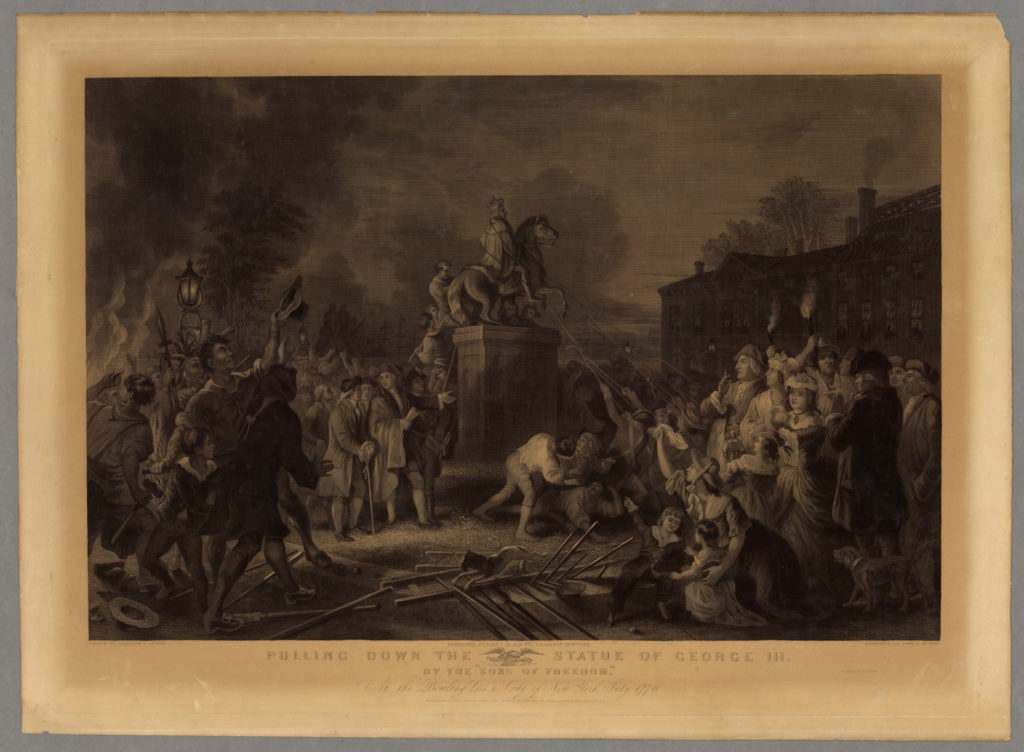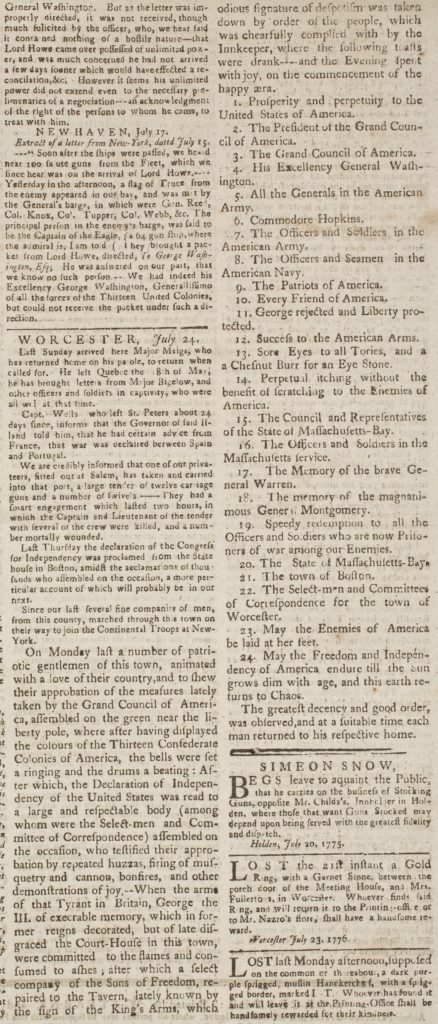Odds are your Fourth of July celebrations will include something along the lines of mounds of food, parades, drinks, bonfires, and fireworks. Turns out, if you add in some minor property destruction and some long-winded toasts, you’ll be right on target with those colonists who celebrated the long-awaited news of Congress’s adoption of independence in July of 1776.
Revelries sprung up everywhere as news of the Declaration spread throughout the colonies during the month of July. In Philadelphia on July 8, the Declaration was “proclaimed at the State-House in this city, in the presence of many thousand spectators, who testified their approbation by repeated acclamations.”[1] In New York on July 9, General George Washington had the Declaration read at the head of each brigade in and around the city, and it was “every where received with the utmost Demonstrations of Joy.”[2] Later that night, a large equestrian statue of King George III in New York, “which tory pride and folly raised in the year 1770, was, by the sons of freedom, laid prostrate in the dirt, the just desert of an ungrateful Tyrant! The lead wherewith this monument was made, is to be run into bullets…”[3] The Declaration was proclaimed in Williamsburg, Virginia, on July 25 and was “received with universal applause, under a discharge of cannon, firing of small arms, illuminations in the evening, &c. &c.”[4]

One of the most thorough descriptions of independence celebrations, however, appeared in the July 24 issue of Isaiah Thomas’s The Massachusetts Spy. Thomas had allegedly made the first public reading of the Declaration of Independence in New England some days earlier when he intercepted a post rider bound for Boston carrying a copy of the Declaration and subsequently read it to a large crowd from the roof of the portico of Worcester’s Meeting House (later known as Old South Church).[5] Several days later, on July 22, a bigger and more formal celebration took place when “a number of patriotic gentlemen of this town, animated by a love of their country, and to shew their approbation of the measure lately taken by the Grand Council of America, assembled on the green near the liberty pole,” where they displayed the colors of the thirteen colonies, rang bells, beat drums, and read the Declaration of Independence to “a large and respectable body (among whom were the Select-men and Committee of Correspondence) assembled on the occasion, who testified their approbation by repeated huzzas, firing of musquetry and cannon, bonfires, and other demonstrations of joy.”

But this wasn’t enough for the “patriotic gentlemen” of Worcester. They followed these demonstrations by removing the King’s arms from the courthouse and burning them, after which a “select company of the Sons of Freedom” went to a tavern that had been known as the King’s Arms and tore down the sign proclaiming it as such. According to this article, the tavernkeeper—a woman named Mary Stearns—“cheerfully complied” with their wishes.
With the hard work of demolishing royal imagery done, the group celebrated by drinking in Stearns’s tavern to twenty-four separate toasts. The toasts began as might be expected: “Prosperity and perpetuity to the United States of America;” “The President of the Grand Council of America;” “His Excellency General Washington;” “Success to the American Arms;” etc. But by the middle of the toasts, the effects of the free-flowing pints appear to have reached the gathered crowd. Toast numbers thirteen and fourteen call for “Sore Eyes to all Tories, and a Chesnut [sic] Burr for an Eye Stone” and “Perpetual itching without the benefit of scratching to the Enemies of America.”
The toasts quickly reverted to more standard fare, with glasses raised to the memory of General Joseph Warren, the state of Massachusetts-Bay, the town of Boston, and so on, ending on a heartfelt and hopeful plea that “May the Freedom and Independency of America endure till the sun grows dim with age, and this earth returns to Chaos.”
The newspaper article concludes with a note that “The greatest decency and good order, was observed, and at a suitable time each man returned to his respective home.” It’s good to know that after they set off cannons, muskets, built bonfires, tore down and burned royal symbols, and in all likelihood got roaring drunk, they showed the utmost decorum in getting home safe and sound.
[1] Pennsylvania Gazette, July 10, 1776
[2] New-York Gazette, and Weekly Mercury, July 15, 1776
[3] The Massachusetts Spy, or, American Oracle of Liberty, July 17, 1776
[4] Dixon and Hunter, Virginia Gazette, July 27, 1776
[5] The story of Thomas’s being the first to publicly read the Declaration in New England first appears in the Massachusetts Spy of July 5, 1826, which also recaps the fiftieth anniversary celebrations, over which Thomas presided. The story is repeated in the diary of Christopher Columbus Baldwin, Thomas’s successor as librarian of the American Antiquarian Society, in his entry of July 4, 1832, where he notes that the story had been retold by Thomas many times over the years. There is no contemporary evidence for Thomas’s reading, but the specificity of the story, as well as Isaiah’s status as a printer who would need to set the text into his newspaper (which he did in the July 17, 1776, issue), does suggest authenticity. Later accounts carry conflicting details, including that Isaiah’s reading and the events of July 22 (sometimes stated as July 24) are the same event.
